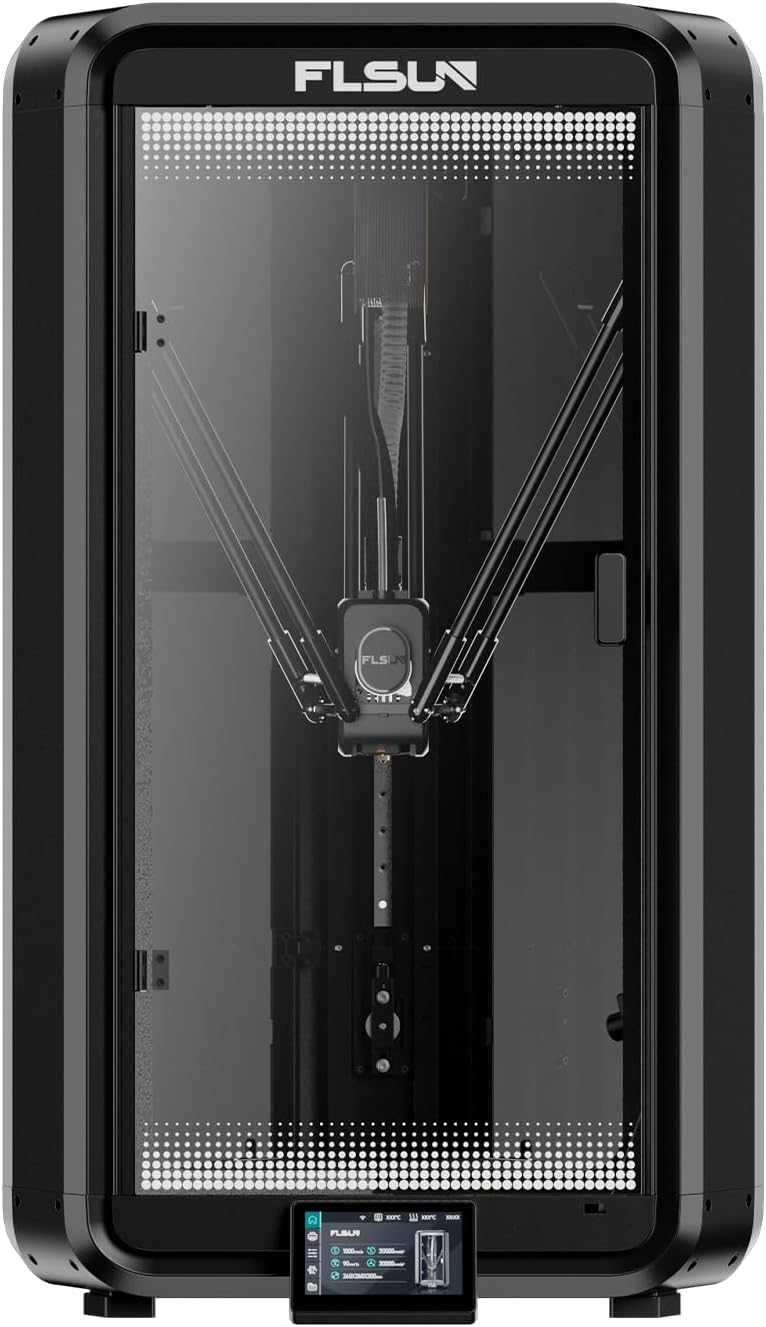This amazing tiny 3d printer FLSUN T1 Pro stands out as a compelling high-speed 3D printing solution, offers us a blend of impressive speed, advanced features, and a user-friendly design. Its headline capability of reaching 1000mm/s printing speed and 30,000mm/s² acceleration positions it as a powerful tool for significantly reducing print times, a crucial factor for rapid prototyping, small-scale manufacturing, and even educational purposes. In this review we have covered its major aspects which make this 3d printer surprisingly great.
The integration of an AI camera for real-time monitoring and error detection, along with the ability to create time-lapse videos, adds a layer of intelligence and convenience to the printing process. The robust dual gear direct drive extruder, capable of reaching 300°C with a 90mm³/s flow rate, ensures compatibility with a wide range of filaments, from common materials to advanced engineering-grade plastics. The enclosed printing chamber further enhances its versatility by providing a stable thermal environment, particularly beneficial for temperature-sensitive materials prone to warping. Features like one-button automatic leveling, a material break detector, and vibration compensation contribute to a more reliable and user-friendly experience, aiming to minimize print failures and maximize print quality, even at high speeds.
No products found.
The Advantages of Good Printing Speeds
The FLSUN T1 Pro boasts a maximum printing speed of 1000mm/s and an acceleration of 30,000mm/s², figures that represent a substantial leap beyond the capabilities of conventional 3D printers. To contextualize these values, a printing speed of 1000mm/s indicates the rate at which the print head moves while extruding filament, while acceleration of 30,000mm/s² refers to how quickly the printer can reach and change its printing speed. These enhanced speeds translate directly into significantly reduced print times. For instance, printing an articulated dragon model that might take over 17 hours on a traditional printer can be completed in approximately 8 hours and 24 minutes on the FLSUN T1 Pro. This near halving of production time has profound implications for various user segments. Hobbyists can iterate through designs more rapidly, educators can demonstrate 3D printing principles with less time investment, and small businesses can potentially increase their output and responsiveness to market demands.
However, achieving optimal results at these elevated speeds necessitates careful consideration of the materials employed. Standard filaments, while suitable for conventional printing speeds, may not possess the properties required to maintain print quality at 1000mm/s. Research indicates the emergence of specialized high-speed 3D printing filaments designed to withstand the increased stress and heat generated during rapid extrusion. Using regular filaments on high-speed printers can lead to issues such as inconsistent extrusion, poor layer adhesion, and even filament breakage, akin to using low-octane fuel in a high-performance sports car. Therefore, to fully leverage the speed capabilities of the FLSUN T1 Pro, users may need to invest in these advanced materials.
It is also important to acknowledge that pushing the boundaries of printing speed can introduce trade-offs with print quality. While the FLSUN T1 solid Pro 3d printer aims to maintain precision even at high speeds, some reviews suggest that achieving optimal quality at the absolute maximum speeds might require careful calibration and material profile tuning. One review noted weaker interlayer adhesion when printing at the highest speeds, resulting in more delicate prints. This highlights the complex interplay between printer hardware, firmware, and filament characteristics in achieving a balance between speed and quality. Simply having fast motors is not the sole determinant of high-quality, high-speed printing; factors such as the printer’s rigidity and the ability to manage the momentum of the rapidly moving print head are also critical. High acceleration, in particular, can place significant physical stresses on the printer’s frame and components, potentially affecting the accuracy of the print.
Despite these considerations, the benefits of high-speed printing extend beyond individual users. The potential for a productivity revolution in 3D printing farms is significant. Operators managing small manufacturing hubs can achieve the same production capacity with half the number of high-speed printers compared to traditional machines, leading to substantial reductions in investment costs and enhanced operational efficiency. Furthermore, the increasing productivity offered by high-speed 3D printing is positioning it as a viable alternative to conventional plastic injection molding for certain applications, particularly for medium and large batch sizes where the cost of tooling for injection molding might not be economically feasible.
Intelligent Monitoring with the AI Camera – Exploring the Role of the Integrated AI Camera
The FLSUN T1 Pro is equipped with an integrated high-definition AI camera, a feature that signifies a growing trend towards smarter and more autonomous 3D printing systems. This camera serves multiple functions, including real-time intelligent monitoring, ensuring print accuracy, and creating time-lapse videos. Real-time monitoring offers users the ability to observe the printing process remotely, providing peace of mind and the opportunity to intervene if any issues arise. By continuously tracking the progress of a print via a smartphone or laptop, users can detect early signs of printing errors, such as layer shifting, stringing, or warping, and potentially halt the process before significant material and time are wasted.
The “intelligent” aspect of this monitoring often involves the use of AI algorithms to analyze the print process in real-time. These algorithms can be trained to recognize specific patterns or anomalies that indicate a potential print failure, such as “spaghettification” where filament strands become tangled and mislaid. By identifying these issues early, the system can send warnings to the user or even automatically pause the print, allowing for corrective action to be taken. Furthermore, AI visual analysis can play a role in ensuring print accuracy by performing first-layer inspection to confirm proper bed adhesion and by analyzing material flow to detect inconsistencies. Some advanced systems can even measure the actual extruded line path and compare it to the expected dimensions, making adjustments to calibration parameters to improve dimensional accuracy.
Power and Precision – Analyzing the Dual Gear Direct Drive Extruder’s Capabilities
The FLSUN T1 Pro is equipped with a dual gear direct drive extruder, a design choice that underscores the printer’s focus on both power and precision in filament delivery. To understand the significance of this feature, it is helpful to contrast it with Bowden extruders, another common type found in 3D printers. In a direct drive system, the extruder motor is mounted directly on the print head, close to the hot end, resulting in a shorter and more direct filament path. This proximity allows for more precise control over the filament’s movement, particularly during retractions, which are crucial for preventing stringing and oozing. Direct drive extruders are also generally preferred for printing flexible filaments like TPU, as the shorter, constrained filament path reduces the likelihood of the filament buckling or flexing before entering the hot end.

